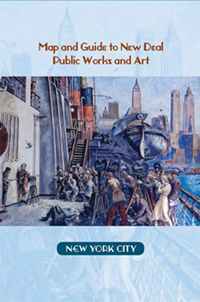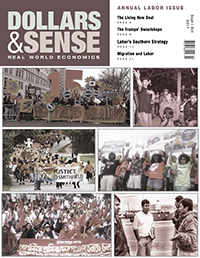The Living New Deal
Events to celebrate New Deal achievements and advocate a "New New Deal" based on Depression-era job-creation programs.

In the depths of the Great Depression, the New Deal mounted job creation programs that put millions of unemployed Americans back to work. The projects they worked on changed the face of the nation, greatly enhancing our physical, environmental, human-service, and cultural resources. The publication of the Map and Guide to New Deal New York City--demonstrating the tremendous impact of these work programs on the City--was an opportunity, not only to show what enlightened government programs had once accomplished, but to promote an updated model of New Deal job creation. That kind of program could help us "build great things again!"

September/October 2017 issue.
Recognizing this opportunity, the National Jobs for All Coalition, which promotes living-wage jobs for all, and Living New Deal, the California-based project that published the Map and Guide and has mapped 13,000 New Deal sites nationwide, worked together to plan a series of events. These events celebrate New Deal achievements and advocate a "New New Deal" based on Depression-era job-creation programs. Proposed full-employment legislation in Congress is modeled on the job-creation approach of the New Deal.
Published this spring, the Map and Guide to New Deal New York City commemorates the creation or expansion of such iconic New York City landmarks as the Lincoln Tunnel, the Triborough Bridge (now Robert F. Kennedy Bridge), and the Whitestone Bridge; Central Park Zoo; Brooklyn College; numerous public buildings; many notable murals adorning the City's schools, post offices, libraries, and court houses; and much more. The launching of the Map and Guide is an occasion to call attention to the persistence of unemployment and its debilitating effects on our people and communities, particularly in the City's economically disadvantaged neighborhoods--where many experience what President Franklin D. Roosevelt called "the despair of idleness." It is also an opportunity to counter pervasive negative attitudes toward government and to provide a shining example of how democratic government was once capable of solving serious national problems.
More than a history lesson, the celebration features national and municipal proposals to combat unemployment and increase the nation's and the City's physical, cultural, environmental, and human-service resources. Unmet physical, environmental, and human service needs are widespread, and the resulting potential for job creation should be obvious as well. The U.S. Society of Civil Engineers gives our neglected, inefficient, and potentially dangerous national infrastructure a grade of D+. The looming environmental disaster calls for massive retrofitting of buildings, flood control construction (particularly in coastal cities like New York), and the repair, upgrading, and expansion of public transportation. Recent chronic delays and interrupted service in what was once NYC's highly efficient subway system, have greatly increased the daily travel time (and frustration) of millions of New Yorkers. And affordable housing? In his article, "Tenants under Siege: New York City's Affordable Housing Crisis" (New York Review of Books, Aug. 17, 2017), Michael Greenberg concludes, "What New York desperately needs is newly constructed buildings entirely devoted to households with incomes of $35,000 to $80,000." How senseless and wasteful to continue to neglect the urgent needs that jobless workers could meet.
The National Jobs for All Coalition (NJFAC) has served as the major consultant to Rep. John Conyers, Jr. (D-MI), chief sponsor of H.R. 1000, the 21st Century Humphrey-Hawkins Full Employment and Training Act. The bill features an updated New Deal model of direct job creation by government as the means of achieving a national job guarantee (JG). An "updated model" means that H.R. 1000 transcends its New Deal predecessors by paying a living wage and employing all who want work, regardless of race, gender, national origin, or sexual orientation. H.R. 1000 would be funded by a financial transactions tax of 1/4 of 1 percent (0.25%) on stock transactions and similar small taxes on futures, options, and swaps transactions.
As part of the celebration of New Deal New York City, NJFAC is proposing a similar approach on the municipal level, a New York City job guarantee. NJFAC has been meeting with city officials to discuss and devise a major government job-creation initiative in New York City as part of a job guarantee and has been exploring means of financing it. Action at the state and local levels--especially in the nation's leading metropolis--could be a model for other localities and could stimulate necessary action at the federal level.
It is important to recognize the relationship between full employment and Social Security. We tend to associate Social Security with income support, but the Cabinet-level committee that planned the Social Security Act emphasized that "the first objective of economic security must be maximum employment." The committee, chaired by Labor Secretary Frances Perkins, consequently proposed "employment assurance" through public works and stimulation of private employment, not only in periods of deep depression but in normal times as well. Relief Administrator Harry Hopkins, who headed the job-creation programs, persuaded President Franklin Delano Roosevelt that it made sense to combine short-term Unemployment Insurance (UI)--then just 17 weeks--with a work program for long-term unemployment.
For reasons still not entirely clear, FDR ultimately opted for UI as part of the permanent legislation of the Social Security Act and a temporary, though large, job-creation program, the WPA. Enacted just prior to the Social Security Act, the program was discontinued when war-time spending temporarily led to full employment. As Frances Perkins observed in the 1940s, "Unemployment insurance stands alone as the only protection for people out of work." Convinced by the experience of World War II that it was possible to create full employment, FDR proposed his famous "Economic Bill of Rights" (or "Second Bill of Rights") with the guarantee of living-wage work as the first and "most fundamental" of these rights. It is the realization of that economic right that is the goal of current efforts by NJFAC and other advocates to enact Full Employment or a Job Guarantee.
An updated model of the work programs is the heart of current full-employment proposals or job guarantees. By "updated," I mean that unlike the New Deal programs, the programs would pay living wage and that being unemployed would be the only eligibility criterion--not income or being on welfare or "relief," the term used traditionally, and the work programs would be entitlements, not limited and discriminatory, but available to anyone who is unemployed. H.R. 1000, the Humphrey-Hawkins 21st Century Full Employment and Training Act, employs this updated model of government job-creation to fill the chronic job gap left by the combination of private-sector and government employment.
NJFAC has recruited a diverse group of sponsors for a series of events to celebrate New Deal accomplishments and to advocate policies to meet current crying needs. Major sponsors, in addition to NJFAC and the Living New Deal, are the New School for Social Research which is hosting a public meeting to Celebrate and Promote the Dual Legacy of job creation and resource development in the fall, and the Columbia University Seminar on Full Employment, Social Welfare, and Equity. Economics professor Franklin D. Roosevelt III is the Honorary Chair of Celebrating New Deal New York City, and co-sponsors include major unions, environmental groups, religious organizations, and social justice advocates.
The Map and Guide was launched in May with events at Roosevelt House and the Museum of the City of New York that included a slide lecture by Living New Deal founder and Project Scholar Gray Brechin and appearances by such noted New Deal historians as Ira Katznelson and William Leuchtenburg. In June, an all-day conference, "When Government Was the Solution: The New Deal's Forgotten Legacy, Then and Now," was sponsored by the New York Labor History Association and the Association of Teachers of Social Studies (United Federation of Teachers) (with support from the Professional Staff Congress of the City University of New York (American Federation of Teachers) and NJFAC). The Social Studies Teachers group has made the New Deal the focus of its work in the coming academic year, and 1,000 copies of the Map and Guide are favailable to members who request it for classroom use.
The culminating event in Celebrating New Deal New York City is a Public Meeting at The New School on October 27, "A New ?New Deal' for NYC & the USA" (see the back cover of this issue). The program will include Rep. Marcy Kaptur (D-OH) sponsor of the 21st Century Civilian Conservation Corps Act (H.R. 2206), and a co-sponsor of H.R. 1000. The CCC was the most popular New Deal program, rescuing millions of youth from unemployment and contributing greatly to the protection and upgrading of the nation's environment. A panel of distinguished economists, all of whom have contributed to developing the 21st century full-employment proposals, will discuss "Political and Economic Prospects for Achieving Federal and New York City Job Guarantees." NYC Public Advocate Letitia James has been invited to discuss unemployment and the role of a job guarantee for the City. James' office is working on a bill for a phased-in Job Guarantee for New York City, and NJFAC experts have been providing consultation to them. To make sure that the co-sponsors and participants in the Celebration of New Deal New York City continue to work together toward "building great things again" and the advocacy of federal and New York City job guarantees, the Modern Money Network--which aims to bring accurate and accessible knowledge of monetary and financial systems to the broader public--is hosting a strategy session the following day, October 28, at the Columbia University Law School.
